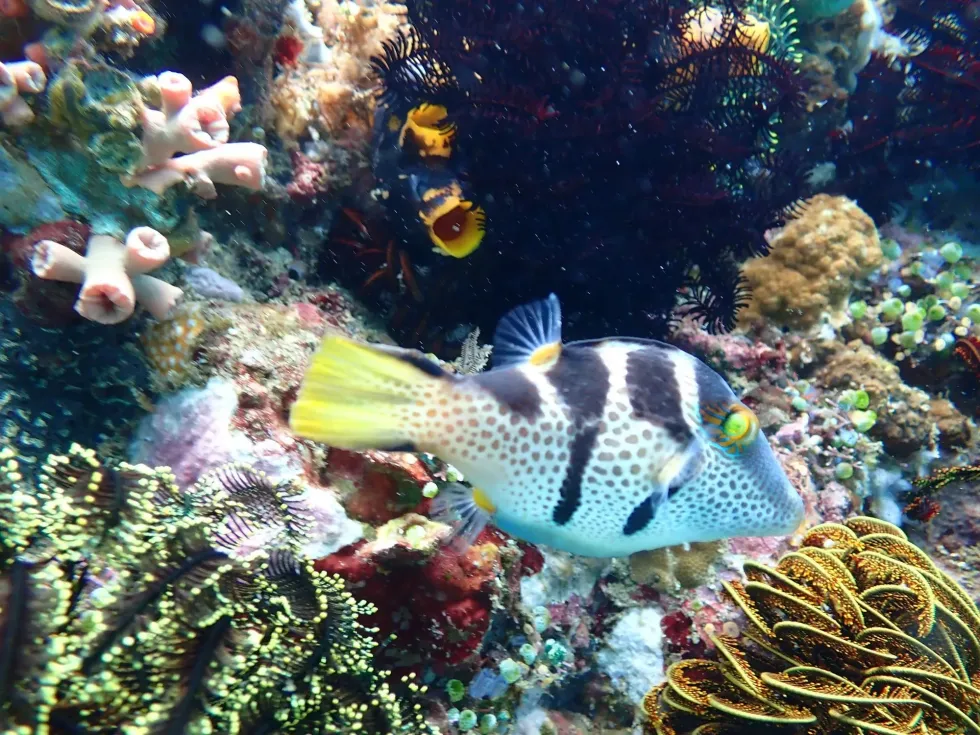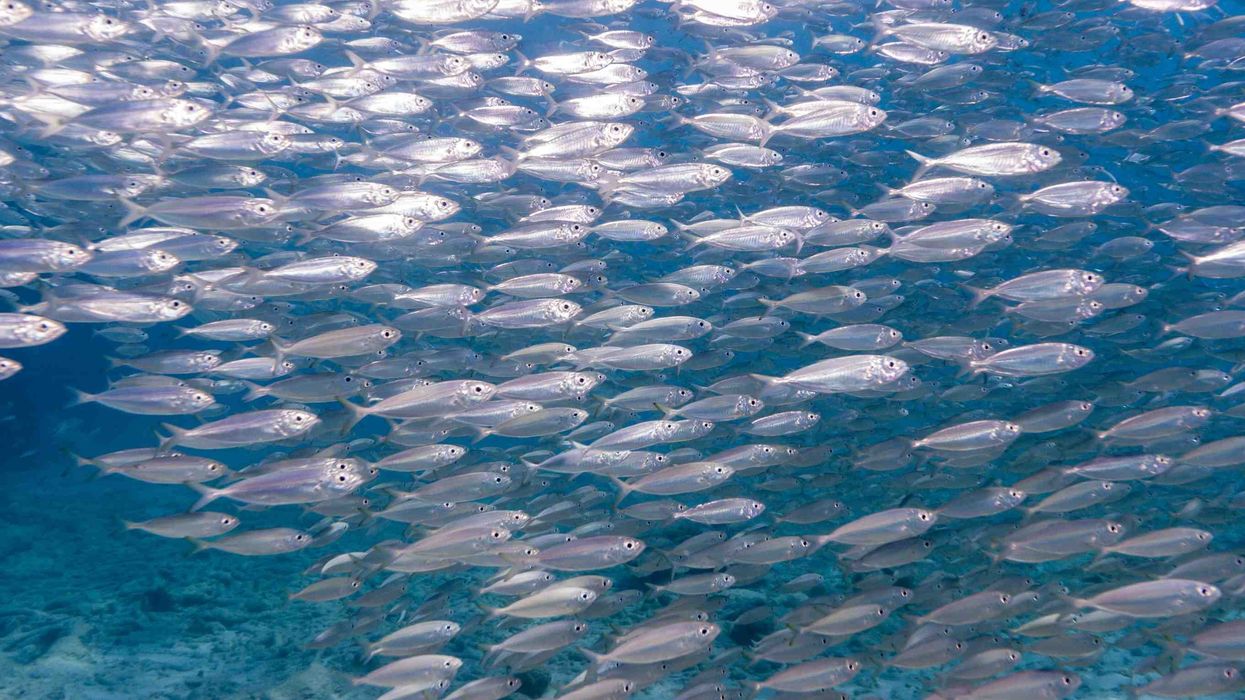A filefish (Paraluteres prionurus) is one of the most intriguing fish that are found in our seas. This species is closely related to triggerfish and comes from the family Monacanthidae.
A blacksaddle filefish (Canthigaster valentine) is a species of very friendly and calm, fishes, they can easily be frightened and often do not show much predatory behavior. Many researchers also believe that these species of fish can even show false puffer behavior, although this filefish, Paraluteres prionurus, is often found in small schools and pairs in their natural habitat.
A mimic filefish, endemic to the Red Sea, is also very interesting and a topic of curiosity, as these fishes got their famous name because they evolved to mimic another species. The blacksaddle fish closely mimics the poisonous blacksaddle toby (Canthigaster Valentini).
A blacksaddle leatherjacket is often found on reef-safe swimming with other species of fish.
The filefish, Paraluteres prionurus, is also seen swimming along with their doppelganger blacksaddle toby in the Indo-Pacific Ocean. However, this isn't the complete tale about how they mimic fishes for their survival, a filefish mimics pufferfish as well to escape predators.
Although, their dorsal fins are very different from the paddle-like fins of the pufferfish.
Thus, these species of fish are excellent when it comes to surviving at sea and saving themselves from predators, their coloration helps them to a great extent, however, they are not poisonous like the species which they mimic (Valentine puffers).
To learn more about such intriguing sea creatures make sure to check out our articles on blobfish and walleye fish.
Mimic Filefish Interesting Facts
What type of animal is a mimic filefish?
A blacksaddle filefish leatherjack is a type of fish and it belongs to the family Monacanthidae. These fish are known to be some of the smartest fish, as over the years they have evolved to fool their predators by mimicking different more poisonous fishes, such as the blacksaddle toby and also the Valentini puffers.
Although, you can identify them just by noticing their dorsal spine and their dorsal fin, which is very different from both blacksaddle toby and pufferfish.
What class of animal does a mimic filefish belong to?
A mimic filefish belongs to the Actinopterygii class, they are also closely related to the triggerfish. These fish belongs to the family Monacanthidae and genus Paraluteres.
How many mimic filefish are there in the world?
A filefish mimic or blacksaddle leatherjack has around 102 species and 27 genera. These fishes evolved to mimic their related species Canthigaster valentini, to have better feeding grounds under the sea as most predators won't be attracted to a poisonous fish. The exact population of this fish is not known.
Where does a mimic filefish live?
This blacksaddle leatherjacket fish is said to live in both the Pacific and Indian oceans. They are also assumed to live on the reefs in the coral sea and the great barrier reef of Queensland as well.
What is a mimic filefish's habitat?
Their natural habitat is mostly reefing across the Indo-Pacific Oceans. For their artificial living conditions, they prefer their aquarium to be non-reef saltwater, the tank should have hard water, and in ideal tank conditions, these fish are good for beginners.
Although, it's important to understand to not pair them with other species of filefish in their aquarium, as they do not get along well with them even in their marine. It can be good to mimic some flora and fauna from their marine habitat.
Who do mimic filefish live with?
This blacksaddle leatherjacket lives with many species of fish and mostly they are in small schools with the blacksaddle toby, their shape and coloration are almost similar, thus they are hard to distinguish by predators. Other species that live within the Indo-Pacific Oceans are Pacific salmon and triggerfish.
How long does a mimic filefish live?
A blacksaddle leatherjacket lives for around three to five years in the coral sea and as well as in its other habitats.
How do they reproduce?
These yellow-tail fishes reproduce like any other fish, the female simply leaves her eggs on the subtract, which are later fertilized by the male. This method of reproduction is called spawning and females often guard their eggs against being eaten.
You can even breed these fish in their home aquarium by simply providing the same condition they have in coral and marine.
What is their conservation status?
These fish have evolved to act like puffers and their skin very much mimics the blacksaddle toby. However, despite these attempts and such smart survival techniques, the blacksaddle leatherjack is present in very few numbers. The conservation status of this fish is Not Evaluated.
Mimic Filefish Fun Facts
What do mimic filefish look like?
A mimic filefish is a shore-frequenting marine fish.
They live in the warm seas across the world and mimic several fishes, one of them is puffer-fishes - they even act and behave as puffer-fish, due to their evolution. These fish do not have a puffer, rather they are flattened on both sides and have two dorsal fin spines.
Their spines are enlarged from their tail base, they can come in various colors, some of them have a yellow body and orange markings, others have an orange line from their eyes to their tail, some have a yellow tail of triangle shape.
How cute are they?
This blacksaddle leatherjacket is very cute and their evolutionary behavior makes them even cuter. They are colorful and quiet, they have a delicate spine, that runs till their tail, feeding sessions with time at a home aquarium can be an absolute delight.
How do they communicate?
Fish mostly communicate when they have food, in this case, algae and inverts, they also communicate when they are swimming at the reef. Effective communication in fishes is done through sound, color, and electrical impulses.
How big is a mimic filefish?
A fluke fish is three times bigger in size compared to a blacksaddle leatherjacket, whereas a drum fish is 10 times bigger than this species.
How fast can a mimic filefish swim?
Filefish, Paraluteres prionurus, are often found in small schools and pairs with fishes of other species. It's known that these fish swim very fast and most times they are successful in avoiding predators.
How much does a mimic filefish weigh?
The weight of a mimic filefish is not yet evaluated.
What are the male and female names of the species?
A blacksaddle leatherjacket has numeral names they are called false puffer, mimic leatherjacket, hooked filefish, and some other six to seven names which people call them in different regions. However, their true name is mimic saddle puffer and they do not have different names for their male and female sexes.
Fishes have the ability to switch their sex after giving birth, which is why both male and female fishes are addressed with similar names.
What would you call a baby mimic filefish?
Once the yolk sac is fully absorbed the baby fish is called fry. Fry are young fishes who are yet to go through several development stages, but they are ready to start eating on their own.
What do they eat?
Their eating habits are almost similar to other filefish. They mostly feed on invertebrates, worms, eggs of other fishes, sometimes a mixed diet of sea algae and meaty food, but invertebrates constitute a large part of their diet. Because of this, they are not reef safe and they also munch down corals.
Are they dangerous?
No these small tail fishes are not dangerous to humans at all, in fact, they aren't even poisonous, they simply mimic species who are poisonous to have a safer surrounding for themselves.
Would they make a good pet?
Yes, a mimic saddle puffer can be an incredible pet. They are also ideal for beginners and do not require much care-taking.
Did you know...
To distinguish between a blacksaddle toby and a blacksaddle leatherjacket, you can look at the fins of the fish. The fins of this species on the other hand are very different and mostly flattened.
What type of fish is a mimic filefish?
A mimic filefish is a hard water fish, with a small body. They are suitable for non-reef saltwater aquariums.
Is the mimic filefish aggressive?
No, a mimic filefish is not aggressive, these fishes mimic the blacksaddle toby which is very aggressive in the corals and can also be aggressive in the tank or aquarium. However, a blacksaddle leatherjack is not aggressive at all.
Here at Kidadl, we have carefully created lots of interesting family-friendly animal facts for everyone to discover! Learn more about some other fish from our Caribbean reef shark facts and Horn shark facts pages.
You can even occupy yourself at home by coloring in one of our free printable mimic filefish coloring pages.
Second image by Francois Libert.










